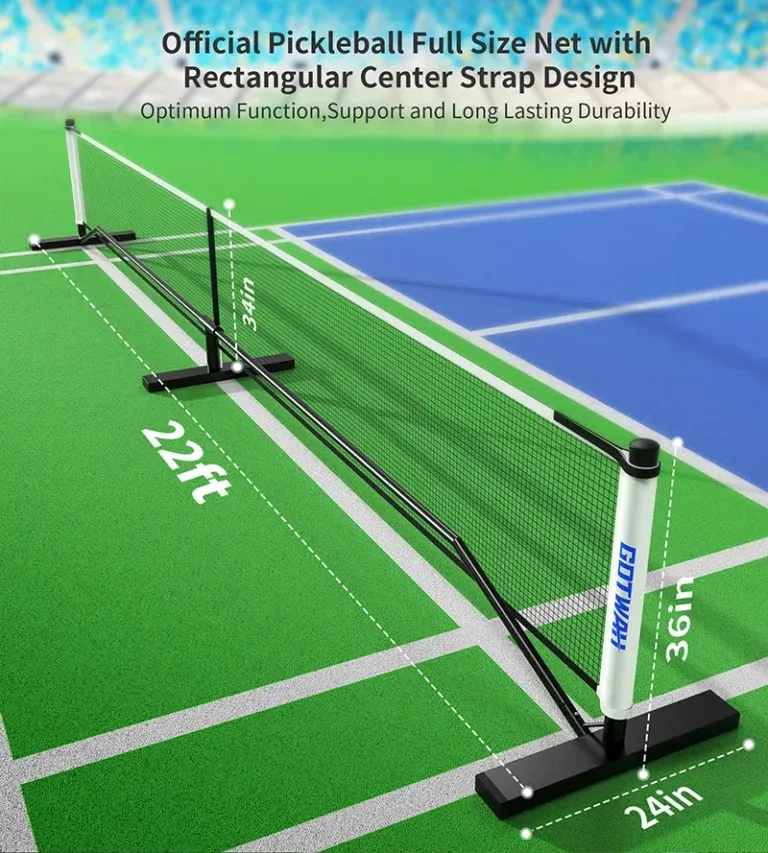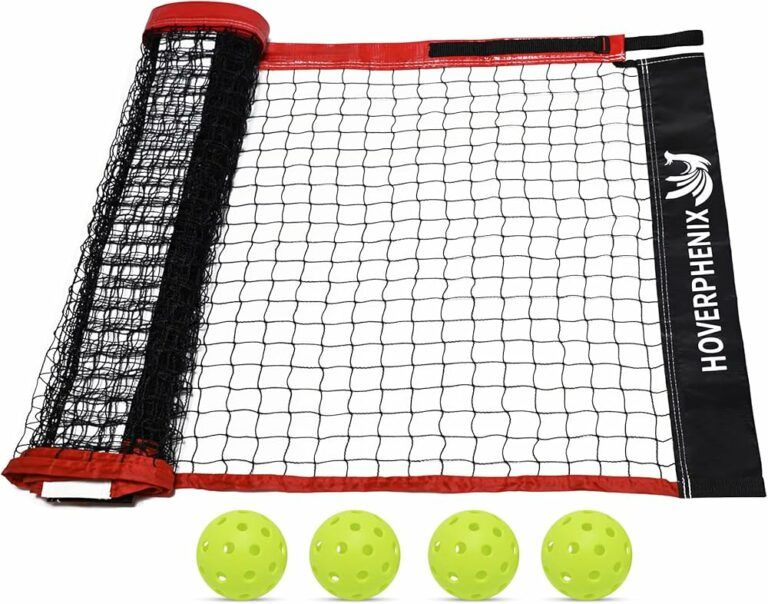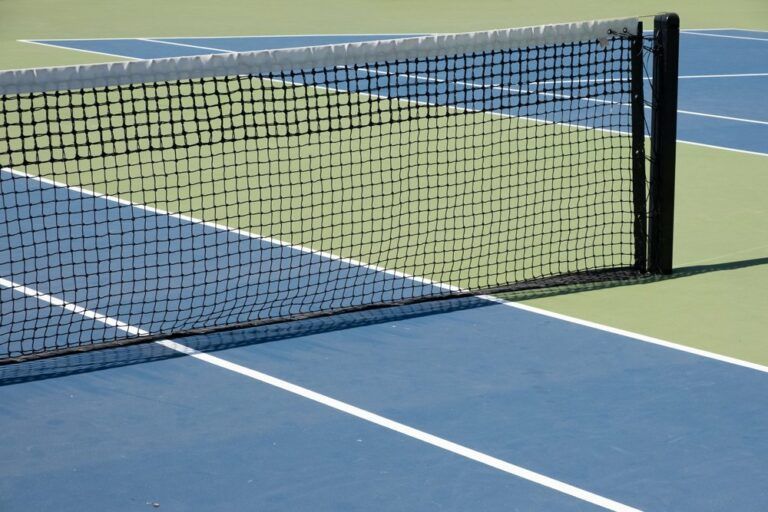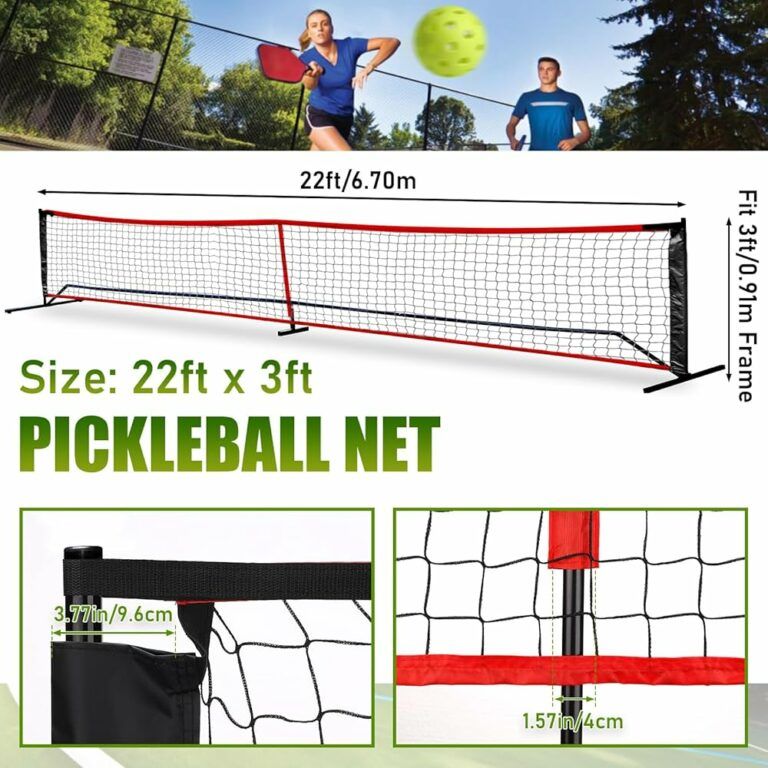Understanding pickleball nets
Pickleball net basics: Understanding the essential components and terminology associated with pickleball nets is crucial for any player or club manager. At its core, a pickleball net consists of various components like the netting itself, side straps, center straps, tensioning devices, and the posts that hold everything in place. The netting typically is made of durable materials like nylon or polyethylene, designed to withstand outdoor conditions.

Standard pickleball net measurements: When examining pickleball nets, it's vital to recognize the specific measurements that differentiate them from other sports nets. According to USA Pickleball regulations, a standard pickleball net is at least 20 feet wide, with a height of 36 inches at the ends and 34 inches at the center. Regular checks on these dimensions will ensure compliance with the official standards and provide an optimal playing experience.
Pickleball net vs. tennis net: While it may seem simple, understanding the differences between a pickleball net and a tennis net can impact your game. First, the height difference is significant; tennis nets are 36 inches high at the center but vary in width significantly depending on the type of court. This distinction is critical for proper gameplay, as using a tennis net can lead to unpredictable bounces and affect the pace of play.
Do you need a special net for pickleball?
Dedicated pickleball nets: Choosing a net specifically designed for pickleball is essential for ensuring an optimal playing experience. Special nets provide appropriate dimensions and tension settings required for the game, which can dramatically affect ball bounce, accuracy, and player performance. Furthermore, a dedicated pickleball net allows players to focus on playing without the need to constantly readjust or compensate for incorrect specifications.
Adjusting tennis nets for pickleball: If you find yourself in a situation where a pickleball net is unavailable, it is possible to adapt a tennis net for temporary play. However, it requires careful adjustment. This involves modifying both the height and tension of the net to meet the required standards. While this can be a feasible solution, it can bring forth challenges like ensuring that the net remains stable and secure throughout the match.

Assessing your pickleball net's condition
Signs your pickleball net needs replacement: Before diving into replacing your net, look for specific signs indicating that a replacement is in order. Net sagging, for example, disrupts gameplay by creating unpredictable bounces; if you notice excessive sagging, it’s time to consider a new net. Additionally, tears or holes can pose safety risks and lead to interruptions during matches. You should also keep an eye out for loss of tension; an unresponsive net can spoil the game’s flow and affect your performance.
Inspecting for wear and tear: During regular inspections, elements like discoloration, frayed edges, or rusted posts indicate that your net may be weakening. Catching these issues early can save you the trouble of significant repairs down the road. A diligent examination before each season or after storms will help maintain the net's integrity and ensure you continue to enjoy high-quality games.
Choosing the right replacement net
Types of pickleball nets: Permanent vs. temporary/portable
When it comes to replacing your net, understanding the type of net that best suits your needs is vital. Permanent nets are excellent for dedicated courts and provide stability, while portable nets cater to recreational players or those who play in various locations. Each option has its benefits depending on your gameplay needs.

Material matters: Exploring different net materials
When selecting a net, take time to review the materials used. Options like nylon and polyester are highly durable and weather-resistant, making them suitable for outdoor play. Balancing durability with budget can significantly impact your choice, but investing in high-quality materials often leads to longer-lasting equipment.
Specialty nets: Options for indoor, outdoor, and adaptive play
If your pickleball matches occur indoors or in specific environments, consider specialty nets designed for those conditions. These nets may emphasize lightweight designs or reinforced materials to withstand unique challenges like fluctuating temperatures or varying humidity levels.
Factors to consider: Budget, durability, and intended use
Before making a final choice, evaluate factors such as cost, how often you plan to play, and the environment in which the net will be used. A carefully balanced decision will help ensure you invest in a net that suits your long-term gameplay demands.
Industry standards: Meeting USAPA requirements
It’s essential to select nets that abide by regulations set by the USA Pickleball Association (USAPA). This means adhering to height and width specifications, as well as ensuring the material meets intensity standards. Always look for certifications or recommendations to ensure compliance.
Replacing a pickleball net: A step-by-step guide

Permanent pickleball net
Essential tools and materials for permanent net replacement
To successfully replace a pickleball net, you’ll need specific tools like a measuring tape, replacement net, and essential hardware like T-stakes and tensioning straps. Preparation will facilitate a smoother process and minimize the risk of oversight.
Removing the old net: A detailed process
Begin by carefully detaching the existing net from the posts. Ensure you unclip or unhook any fasteners without damaging the supporting posts. It’s helpful to note the order and setup details, as these can guide the reinstallation process, especially if it's a permanent structure.
Installing the new net: Alignment and attachment
With the old net removed, start preparing your new net: unbox it and identify key components like the center straps and end sleeves. Attaching the new net involves securing one end to its designated post first, followed by the other end while ensuring the net hangs evenly.
Tensioning and adjusting the net height
Once the net is secured in place, measure the height at both sidelines and the center regularly. The USA Pickleball regulations require a height of 36 inches at the posts and 34 inches in the center. Use the tensioning straps to adjust as necessary, ensuring the net is taut without being excessively tight.
Ensuring correct height: 36 inches at posts, 34 inches in the center
Final adjustments involve a meticulous check to confirm the net meets the stated dimensions. You can effectively ensure this by gently hitting a ball over the net to observe the bounce and responsiveness. This check can save future frustrations during gameplay.
Replacing a portable pickleball net
Dismantling the net frame: Remembering the order of assembly
If you're working with a portable net, carefully dismantle the frame while keeping track of the order of assembly. This is crucial, as it saves time and confusion during reinstallation.
Positioning the new net: Aligning with the posts
Place the new net over the posts and ensure it aligns correctly with the previously marked measurements. This step is vital for achieving competitive play conditions while avoiding unnecessary adjustments later.
Reassembling the net frame: Step-by-step instructions
Follow the original assembly order while securing the net in place. Make sure all fasteners are tight to maintain stability and give yourself the best chance for optimal performance during matches.
Adjusting net tension: Achieving optimal playability
After securing the frame, take another round of measurements and adjust for tension. The goal is not just to meet standards but also to provide the best play conditions for everyone involved.
Troubleshooting common issues during net replacement
Dealing with rusted or stuck bolts
During the removal or installation of nets, you may encounter issues like rusted or stuck bolts. Using penetrating oil can help loosen stubborn fasteners. Remember that safety is paramount; if needed, consider seeking professional help.
Achieving proper net tension
Ensuring adequate tension can sometimes be tricky. Familiarize yourself with the tensioning mechanism of the net you choose; not all nets will adjust in the same way.
Ensuring accurate height measurement
Use multiple measuring devices for verification. This redundancy helps confirm accuracy and ensures compliance with USA Pickleball regulations, enhancing the overall gameplay experience.
Maintenance tips to extend the life of your pickleball net
Cleaning and storage best practices
Routine cleaning of both the netting and the supporting posts can greatly extend the life of your equipment. Using a mild soap solution and letting everything air dry can help prevent mold or decay.
Protecting your net from the elements
If your net is left outdoors, consider using protective covers during adverse weather conditions. Additionally, for portable nets, disassembling and storing them properly offers maximum protection from deterioration.
Regular inspections and minor repairs
Implement monthly inspections to catch signs of wear early and address issues like rust, fraying, or tension loss. Simple repairs can often be done without needing a full replacement, saving you effort and resources.
Cost analysis: Replacing vs. repairing your net
Evaluating the cost-effectiveness of replacement
While the initial expense of purchasing a new net can be high, weigh it against the cost of continued repairs. Sometimes, investing in a new quality net can save you money in the long run thanks to reduced maintenance.
DIY repairs: When they make sense
If minor issues arise, such as small tears or fraying edges, DIY repairs can be effective. However, examining the net as a whole can help you determine whether it’s better to replace the entire system instead of patching up an aging net.
Budget-friendly options for net replacement
There are many affordable options available on the market, such as brands like Franklin Sports that offer budget-friendly nets without sacrificing quality. Do your research to find products that meet quality standards while fitting your budget.
Exploring sustainable and eco-friendly options
Replacement nets made from recycled materials
Consider seeking out nets that utilize recycled materials, offering not only durability but an environmentally friendly option. Brands focusing on sustainability are increasingly available.
Brands committed to sustainable manufacturing
Look for manufacturers that prioritize eco-friendly practices. This may include sustainable sourcing or offering products made from biodegradable materials.
Reducing your environmental impact
Opting for eco-friendly products can significantly reduce your carbon footprint. By selecting products made sustainably, you contribute to environmental preservation while maintaining your passion for pickleball.
Expert advice and recommendations
Insights from professional pickleball players or coaches
Reviewing expert opinions can provide insights that elevate your understanding of equipment selection and maintenance. Pay attention to advice regarding brands that professionals trust, as they often have valuable tips.
Customer reviews and testimonials
Looking through customer reviews can inform your decision-making process. Pay attention to overall feedback from actual users; this can present a clearer picture of product reliability and performance.
Conclusion
Replacing your pickleball net may seem like a daunting task, but breaking it down into manageable steps can ensure a smooth and successful process. By paying attention to the signs, understanding your options, and carefully following installation guidelines, you can revive your game and keep the gameplay optimal for everyone involved. Investing time in maintaining your equipment will not only keep your net in top shape but also enhance your overall enjoyment of this fantastic sport.










